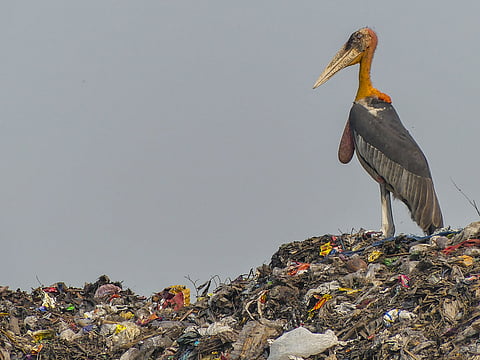
- Home
- Live Blog
- Breaking News
- Top Headlines
- Cities
- NE News
- Sentinel Media
- Sports
- Education
- Jobs

OUR CORRESPONDENT
SIVASAGAR: Against the backdrop of wanton destruction of biodiversity and loss of habitat for wild animals due to increasing anthropogenic activities in the name of development, bird lovers in the state have something to cheer about with a marginal increase of the greater adjutant (Leptoptilos dubius) stork population in the state.
An avid bird watcher Hiren Dutta who has been conferred the title Pakhimitra by the Zonal Research Centre of the AAU in North Lakhimpur, recently conducted a population survey of the species in the district and found over 25 birds right in the middle of the town. Talking to this correspondent on Sunday, Dutta said that the number is definitely more, if physical survey through the length and breadth of the district is done.
Listed under the Red List of Threatened Species of the International Union for Conservation of Nature( INCT) under criteria D1, the greater adjutant stork is one of the largest species of bird with a total wingspan of 250 cm, and a height of about 145 to 150 cm weighing 8 to 11 kg. The word adjutant is used to describe the gait it walks with like a military officer. The Brahmaputra valley was well known as the natural habitat of the stork species greater adjutant known locally as Hargilla(the bone swallower) with a pouch connected to its air passage, and lesser adjutant (L.javanicus) storks(without pouch), next only to Myanmar and Cambodia.
The adjutant stork population dwindled due to numerous causes like destruction of habitat, felling of tall trees where it builds its nest, and increasing use of insecticides, like Furadon and other toxic chemicals used by the farmers in their fields, and tea gardens as measures of pest control. During 1994 - 1996, the population of the species was around 600. But the number must be almost double by now as Whitley Award winner Purnima Devi Burman told Hiren Dutta recently that there are 450 greater adjutant stork nests in Dadora region alone. And if one counts two birds in each nest, the number goes to 900 without counting the storklings. The IUCT assesses that the total number of adult population of greater adjutant storks on August 8, 2023, is around 1360 to 1510.
Some elderly people told that there used to be a big stork population in Sivasagar and nearby marshy land in Saraguwa and Panidihing, part of which(8370.71 acres ) was declared as Panidihing Birds Sanctuary under the Wildlife Protection Act 1972 on 18/12/1995. Until about three decades back the adjutant storks were seen roaming over the large low-laying field and the swamps surrounding the area erstwhile known as Maharami Reserve. It was full of the feed for the stork species. Its feed are mostly crabs, snakes, dead animals, and even small ducklings etc. Further there were numerous tall trees in the area like simul and satiana on the top of which these storks build their nests during breeding season. But, due to gradual loss of habitat, the population of the species gradually dwindled. Fortunately, the consistent conservation efforts of the bird lovers, NGOs and the government combined together has helped to increase the number of the endangered bird.
Also Read: Assam: Awareness Campain Organised on Greater Adjutant Stork Conservation
Also Watch: